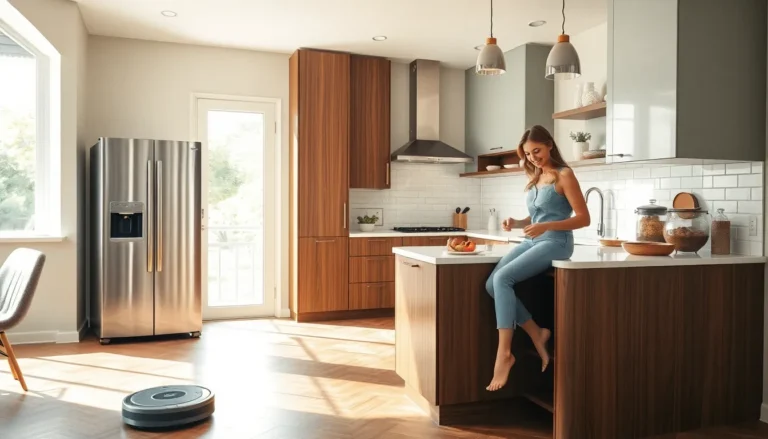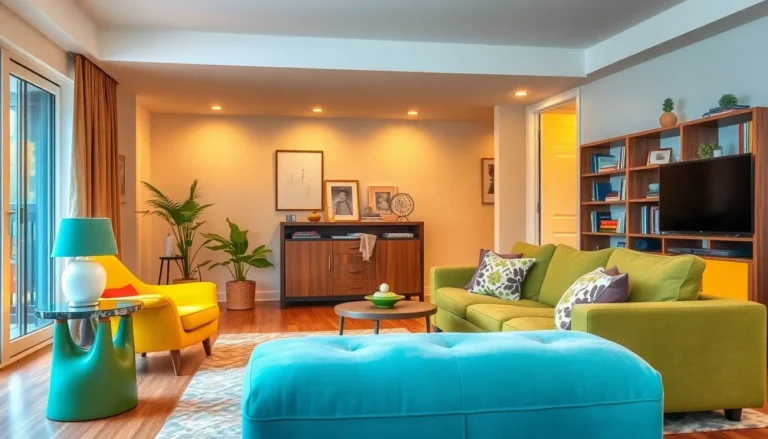Table of Contents
ToggleWhen it comes to flooring, who says you can’t have style and durability? Enter resilient flooring, the unsung hero of home design. It’s like the superhero of surfaces, ready to take on spills, scratches, and the occasional dance party without breaking a sweat. Gone are the days of worrying about your floor when the kids unleash their inner tornado or the dog decides to redecorate with muddy paws.
Resilient flooring isn’t just tough; it’s versatile and stylish too. With options ranging from chic vinyl to trendy linoleum, it fits seamlessly into any décor. Whether you’re a minimalist or a maximalist, this flooring can handle it all while keeping your wallet happy. So why settle for less when you can have a floor that’s as resilient as your favorite pair of sneakers? Let’s dive into the world of resilient flooring and discover why it deserves a spot in your home.
Overview of Resilient Flooring
Resilient flooring stands out as a stylish and durable choice for various home environments. This flooring type excels in endurance against spills, scratches, and significant foot traffic.
Definition and Characteristics
Resilient flooring refers to flexible flooring options that offer comfort and durability. Key characteristics include water resistance, ease of maintenance, and a range of design choices. Resilient options often mimic other materials like wood or stone, providing aesthetic appeal without the associated cost. Its cushioned surface supports comfortable standing and walking, making this flooring ideal for busy households. Additionally, resilient flooring contributes to indoor acoustics by reducing noise levels.
Common Materials Used
Several materials fall under the umbrella of resilient flooring, each offering unique benefits. Vinyl serves as a popular choice due to its versatility and extensive design options. Linoleum, made from natural materials, provides an eco-friendly alternative with a similar look to vinyl. Cork, another resilient option, delivers natural insulation and sound absorption. Rubber flooring, often used in gyms and play areas, offers additional durability and shock resistance. These materials work well in various rooms, including kitchens, bathrooms, and living spaces, enhancing both functionality and style.
Types of Resilient Flooring

Resilient flooring comes in various types, each offering distinct advantages and aesthetic appeal.
Vinyl Flooring
Vinyl flooring stands out due to its versatility and affordability. This material is available in tiles and sheets, allowing for easy installation and customization. Class-leading water resistance makes vinyl suitable for kitchens and bathrooms, where spills are common. Various designs mimic the look of hardwood, stone, or tile, giving homeowners several style options. Its cushioned surface ensures comfort underfoot, making it ideal for long-term use in high-traffic areas. Maintenance is simple, with regular sweeping and occasional mopping needed to keep it looking new.
Linoleum Flooring
Linoleum flooring is made from natural materials, including linseed oil and cork dust, appealing to eco-conscious consumers. This option is durable and provides a unique aesthetic with vibrant colors and patterns. Longevity is a key feature, as linoleum often lasts 20 years or more with proper care. Water resistance is moderate, making it suitable for various spaces, though moisture exposure requires attention. Easy maintenance complements its eco-friendly appeal, requiring only regular cleaning and occasional waxing for upkeep.
Rubber Flooring
Rubber flooring offers exceptional durability and slip resistance, making it popular in commercial and home environments alike. Its surface absorbs impact, providing comfort for areas where people stand for extended periods, such as gyms or playrooms. The material is available in tiles or rolls, allowing for versatile layouts. Noise reduction properties enhance the overall atmosphere, reducing sound transmission between rooms. Cleaning rubber surfaces is straightforward, requiring only water and mild detergents.
Benefits of Resilient Flooring
Resilient flooring provides multiple advantages for homeowners, making it a desirable choice. Its unique properties cater to various needs and preferences.
Durability and Longevity
Durability stands out as a primary feature of resilient flooring. Vinyl, linoleum, cork, and rubber resist everyday wear, ensuring long-lasting performance. Homeowners benefit from reduced maintenance needs as these floors withstand scratches and stains. Significant foot traffic doesn’t diminish their appeal, making them suitable for busy households. Longevity reduces the frequency of replacement, representing a smart investment. The resilience of these materials supports their ability to retain aesthetic qualities over time.
Easy Maintenance
Maintenance remains straightforward with resilient flooring options. Cleaning requires only regular sweeping and occasional mopping using a damp cloth or mild cleaner. Stains typically wipe away easily, eliminating the need for specialized products. Their water-resistant properties help in preventing damage from spills and moisture, further simplifying upkeep. Additionally, homeowners don’t deal with elaborate maintenance routines or frequent repairs. This ease leads to a more enjoyable living environment.
Cost-Effectiveness
Cost-effectiveness is another significant benefit of resilient flooring. Affordable materials like vinyl and linoleum provide stunning designs without high prices. Homeowners enjoy a blend of quality and visual appeal while staying within budget. Furthermore, long-lasting durability minimizes replacement costs over time, enhancing overall value. In terms of installation budget, many resilient flooring types require less investment. Property owners experience savings in both materials and labor, reinforcing resilient flooring as a financially wise choice.
Installation Process
The installation of resilient flooring involves several key steps to ensure a successful outcome. Proper preparation and techniques significantly impact the final appearance and functionality of the flooring.
Preparatory Steps
Ensure the subfloor is clean, dry, and level before beginning the installation process. It often requires removing old flooring and repairing any damage. Additionally, acclimating the resilient flooring materials in the installation area for at least 48 hours stabilizes them against humidity changes. Once acclimated, use a moisture meter to check the subfloor’s moisture level, particularly in basements or areas prone to moisture. Following these guidelines enhances adhesion and durability.
Installation Techniques
Different installation techniques provide versatility based on flooring type. For instance, glue-down installations involve applying adhesive to the subfloor before laying tiles or sheets; this method works well for vinyl and linoleum. Floating installation techniques require no adhesive, allowing planks to interlock and expand naturally, which is common for vinyl plank flooring. Lastly, loose lay installations, where flooring simply rests on the subfloor, make repairs easier and reduce installation complexity. Each method ensures the final product is secure and functional in various residential settings.
Resilient flooring stands out as an exceptional choice for homeowners seeking style and functionality. Its ability to endure daily wear and tear while offering a range of design options makes it a practical investment. With materials like vinyl and linoleum providing both aesthetic appeal and budget-friendly solutions, it’s clear why many are turning to resilient flooring for their spaces.
The comfort and ease of maintenance further enhance its appeal, ensuring that busy households can enjoy beautiful floors without the hassle. Whether it’s for a kitchen, bathroom, or living area, resilient flooring proves to be a smart and stylish addition to any home. Embracing this flooring option not only elevates interior design but also adds lasting value to the property.





